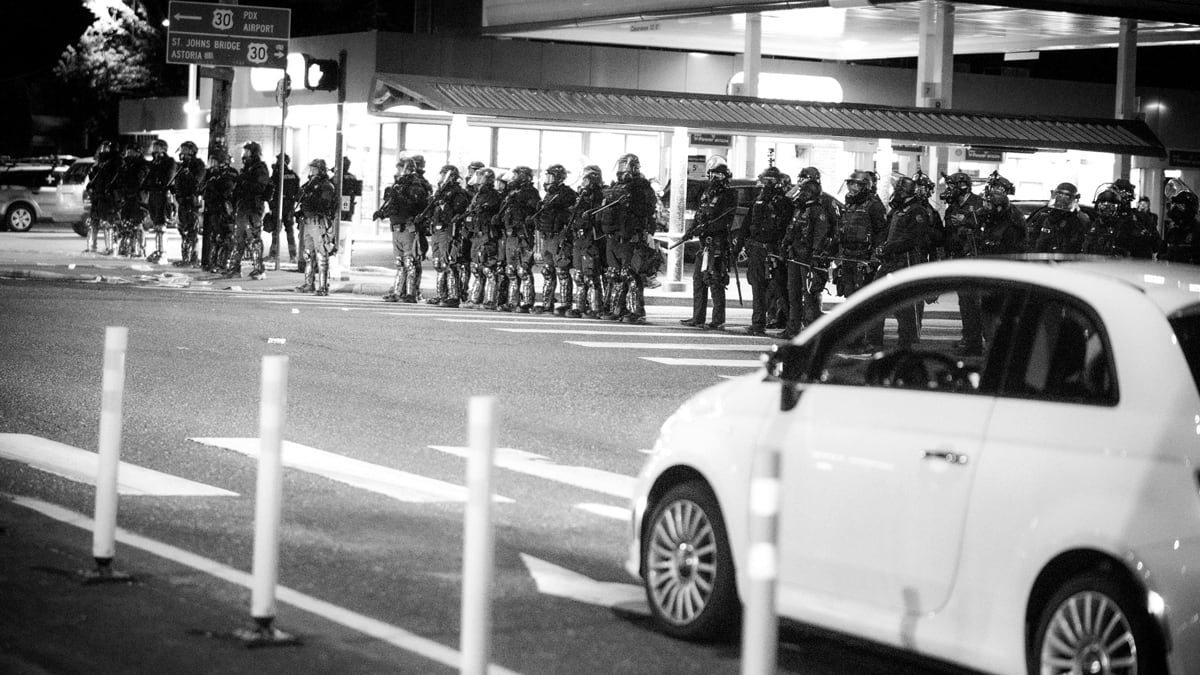Alan Kessler had a simple question 16 months ago: How could he obtain the names of members of the Portland Police Bureau’s Rapid Response Team?
Kessler, a public interest lawyer and political activist, monitored the nightly protests in 2020 and noticed in some videos that certain officers on the riot squad who appeared to use excessive force had obscured their name tags and instead wore numbers as a form of identification.
Kessler filed a public records request with the city of Portland seeking a numeric key that would match officers’ names to the numbers they wore during protests.
His quest to get those names lasted longer than the riot squad itself, which voted to disband in June.
On Oct. 18, after a withering opinion letter from Multnomah County Judge Pro Tem Terence Thatcher that excoriated the City Attorney’s Office, Kessler finally got what he wanted—and, in the process, definitively solved a long-simmering mystery.
What was Kessler’s beef?
During the protests, the Police Bureau instituted a new policy—citing officers’ fears for their personal safety—that allowed officers working protests to cover their badges and name tags with a six- or seven-digit number that the city assigns all employees. Those numbers are linked to all sorts of personal information: Social Security numbers, home addresses and personal phone numbers.
Kessler says he simply wanted to be able to match the numbers that officers wore to their names so they could be held accountable if they used excessive force.
“Police have great power, and with great power comes great responsibility,” Kessler says. “Having officers know if they abuse their power that people will hold them accountable is one of the checks we have against police brutality.”
Without officers’ names, Portlanders couldn’t file complaints.
Kessler filed a public records request June 17, 2020, seeking a list of names and the corresponding identifying numbers. The city rejected his request, citing a requirement in the law that Kessler provide the officers’ names first (“Look Up the Number,” WW, July 22, 2020).
It was circular logic: To discover officers’ names, Kessler first had to provide them to the city.
What happened?
Kessler appealed the city’s denial to the Multnomah County District Attorney’s Office. The DA appeared to sympathize with Kessler’s argument but said the city’s denial was legally justified. “Frustration at being asked to do the impossible (or impractical) is understandable,” then-DA Rod Underhill wrote in a July 17, 2020, order rejecting Kessler’s appeal.
What changed?
An eagle-eyed judge noticed a flaw in the city’s response.
After Underhill rejected Kessler’s appeal, the lawyer filed a lawsuit against the city in Multnomah County Circuit Court. After both sides presented their positions to Judge Pro Tem Thatcher, the judge noticed that Kessler had included a photograph with his complaint—it showed a Rapid Response Team officer with a two-digit number on his uniform. That number, the judge realized, was different from the six- and seven-digit numbers linked to personal information that the city refused to give to Kessler.
Moreover, he realized, the city had never addressed the existence of this second numbering system.
In an Oct. 11 opinion letter to both parties, Thatcher unloaded on the city.
“The City hid that fact from Kessler (and later the district attorney and this Court) when any good faith interpretation of Kessler’s request would have read it to include those numbers,” Thatcher wrote. He gave the city until Oct. 18 to either provide Kessler the two-digit numbers and corresponding names or a justification for withholding them.
A little after 4 pm that day, the city sent Kessler the list.
What does that mean?
Portlanders can now comb through photographs and video of the protests and determine the names of officers involved in various incidents.
And the list, which Kessler shared with WW, provides a definitive answer to a long-running question: Who is Officer Number 67, who was captured on video Sept 5, 2020, slugging Elijah Warren, a homeowner, with his baton? The list says the officer, as WW surmised from witness accounts (“The Big Numbers: 67,” Nov. 4, 2020), is Detective Erik Kammerer.
As for the delay in releasing that information, City Attorney Robert Taylor says it was a misunderstanding. “During this matter, a disagreement arose about the scope of the plaintiff’s public records request, and the court resolved that disagreement with its decision,” Taylor tells WW. “We thank the court for its decision.”
Correction: Due to an editor’s error, this story initially misstated the month when the Rapid Response Team disbanded. It was June, not July.
